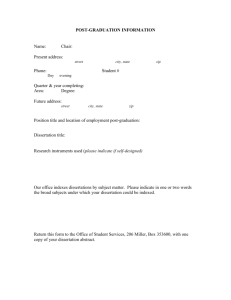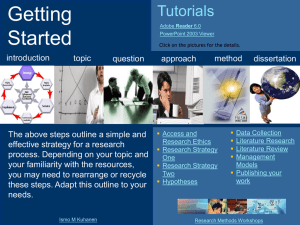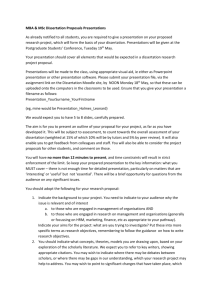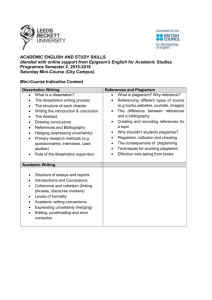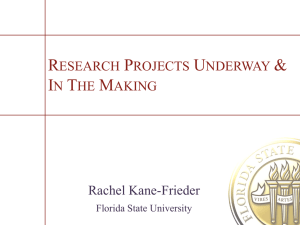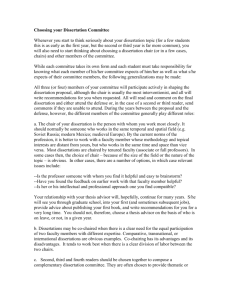table of contents - Texas A&M University
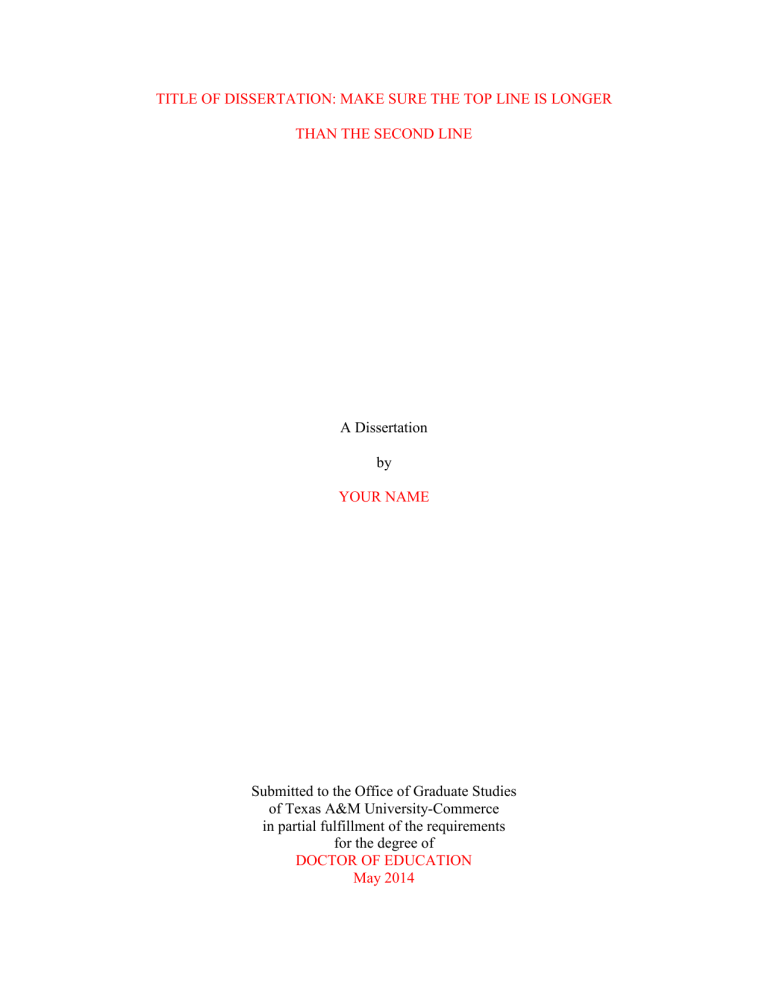
TITLE OF DISSERTATION: MAKE SURE THE TOP LINE IS LONGER
THAN THE SECOND LINE
A Dissertation by
YOUR NAME
Submitted to the Office of Graduate Studies of Texas A&M University-Commerce in partial fulfillment of the requirements for the degree of
DOCTOR OF EDUCATION
May 2014
TITLE OF DISSERTATION: MAKE SURE THE TOP LINE IS LONGER
THAN THE SECOND LINE
A Dissertation by
YOUR NAME
Approved by:
Advisor:
Committee:
Bob Brown
Jim Johnson
Jill Smith
Joe Perry
Head of Department: Kathy Jones
Dean of the College: Jane Doe
Dean of Graduate Studies: Arlene Horne
Copyright © 2014
Your Full Name iii
ABSTRACT
TITLE OF DISSERTATION: MAKE SURE THE TOP LINE IS LONGER
THAN THE SECOND LINE
Your Name, EdD or PhD
Texas A&M University-Commerce, 2014
Advisor: Name of Your Advisor, EdD or PhD
Instructions: Your proposal abstract should include the purpose and procedures with results and conclusions being added in your final dissertation, though you may present the information in whatever format you choose. If your abstract extends to two pages, the second page is numbered at the top right as are all pages throughout the proposal or dissertation. An abstract shall not exceed 350 words and must be doubled-spaced as is the remainder of the dissertation.
Any term (or numeral) with a space on either side is counted as one word. iv
Abstract Continued …. v
ACKNOWLEDGEMENTS
Include this page in your proposal even if you do not fill it out. As an example: “This dissertation would not have been possible without the support of my family, friends, and colleagues providing humor, suggestions, encouragement, and scholarly advice.” You may choose to thank your major adviser and committee members (by name) with specifics. Try to keep your acknowledgements to one page. vi
vii
TABLE OF CONTENTS
LIST OF TABLES ....................................................................................................................... #
LIST OF FIGURES ..................................................................................................................... #
CHAPTER
1. INTRODUCTION ...................................................................................................... #
Statement of the Problem (Level 1 heading in APA 6 th ) .............................................. #
Purpose of the Study ............................................................................................ #
Research Questions (generally for Qualitative Research) ................................... #
Hypotheses (generally for Quantitative Research) .............................................. #
Significance of the Study ...................................................................................... #
Method of Procedure ............................................................................................ #
Selection of Sample (Level 2 heading in APA 6 th ) .......................................... #
Collection of Data .................................................................................... #
Step 1 (Level 3 in APA 6 th ) ................................................................ #
Step 2 .......................................................................................... #
Subheading 1 (Level 4 heading in APA 6 th ) ............................. #
Subheading 2 .................................................................... #
Treatment of the Data .............................................................................. #
Definitions of Terms ............................................................................................ #
Limitations ........................................................................................................... #
Delimitations ........................................................................................................ #
Assumptions ......................................................................................................... #
Organization of Dissertation Chapters ................................................................. #
viii
CHAPTER
2. REVIEW OF THE LITERATURE ............................................................................ #
Instruction: Usually organized by subtopics ...................................................... #
3. METHOD OF PROCEDURE ..................................................................................... #
Design of the Study .............................................................................................. #
Instrumentation .................................................................................................... #
Sample Selection .................................................................................................. #
Data Gathering ..................................................................................................... #
Treatment of Data ................................................................................................ #
4. PRESENTATION OF FINDINGS (or DATA) .......................................................... #
Instruction: Usually organized by hypotheses or by research questions
5. SUMMARY OF THE STUDY AND THE FINDINGS, CONCLUSIONS,
IMPLICATIONS, AND RECOMMENDATIONS FOR FUTURE RESEARCH ..... #
REFERENCES ............................................................................................................................ #
APPENDICES ............................................................................................................................. #
Appendix
A. Hints: Typing the TOC in MSWORD 2007 Or 2010 ......................................... #
B. Hints: Placement and Labeling of Tables and Figures ......................................... #
C. As Needed ............................................................................................................ #
VITA ............................................................................................................................................ #
ix
LIST OF TABLES
TABLE
1.
If a table title is 2 or more lines, the entry in the List of Tables should always be double spaced like this ...................................................................................................... #
2.
Include this page in proposal, even if you have no tables at that time ............................. #
3.
But, remove words in red ................................................................................................. #
4.
............................................................................................................................................ #
5.
............................................................................................................................................ #
x
LIST OF FIGURES
FIGURE
1.
If a figure title is 2 or more lines, the entry in the List of Figures should always be double spaced like this ...................................................................................................... #
2.
Include this page in proposal, even if you have no tables at that time ............................. #
3.
But, remove words in red ................................................................................................. #
4.
............................................................................................................................................ #
5.
............................................................................................................................................ #
1
Chapter 1
INTRODUCTION
Begin the details of the INTRODUCTION. Each chapter must be formatted in the same way with ALL pages numbered at the top right with Arabic numerals beginning on THIS page.
All pages previous to THIS page are in lower case Roman Numerals.
Statement of the Problem
This section should consist of a minimum of 1-2 paragraphs discussing the statement of the problem as it relates to your research.
Purpose of the Study
This section should provide a minimum of 1-2 paragraphs addressing the purpose and justification for completing the study.
Hypotheses
The hypothesis is “the researcher’s prediction, derived from a theory or from speculation, about how two or more variables will be related to each other” (Gall, Gall, & Borg, 2007, p.
642). Hypotheses are REQUIRED if you are doing a quantitative study. Hypotheses are
FORBIDDEN in pure qualitative studies. Always provide an introduction for numbered lists:
1.
Begin numbered lists at the ½ inch indent and continue the sentences aligned under the first letter of the list.
2.
Also, “hypotheses can be stated in two forms, directional and null” (Gall et al., 2007, p. 50).
Research Questions
Research questions are used if you are conducting either a qualitative or quantitative study or a combination thereof. Again, always provide an introduction for numbered lists:
2
1.
Be inclusive and exhaustive when delineating your research questions. They will define your study.
2.
And remember, “The reader needs to know why the researcher framed the question . .
. and how research findings relating to it are likely to advance knowledge and improve educational practice” (Gall et al., 2007, p. 52).
Significance of the Study
The significance of the study should accomplish three tasks:
1.
Describe the gap in the literature.
2.
Describe how this study will (at least partially) fill that gap.
3.
Demonstrate that the researcher is competent to conduct this study.
These tasks will require a reasonably thorough review of the literature to demonstrate knowledge of the subject to be studied. The literature review in this section of the proposal (Significance of the Study), while extensive, is not nearly as in-depth as that of Chapter 2 in the dissertation, which requires a detailed comprehensive examination of at least four or five related studies.
However, some of the literature reviewed in Chapter 2 is always contained in this section of the proposal as well.
Method of Procedure
This section describes in detail what you intend to do with the data once you have collected them. You may refer to any edition of Gall, Gall, and Borg’s Educational Research:
An Introduction , for an overview of several different approaches. Below are examples of how to separate and identify the appropriate subsections.
Selection of Sample
Describe in detail how you selected the participants/sample for your study.
Collection of Data
Step 1. Describe in detail how you collected your data.
Step 2.
You may not have a series of steps involved in collecting your data. This is just an example. Only use this Level 3 heading if you have two or more sections that can go in a
Level 3 heading section.
Treatment of Data
Describe in detail the treatment of data.
Definitions of Terms
Dissertation. According to Grove (1964), a dissertation is
“A substantial paper that is submitted to the faculty . . . for an advanced degree that is typically based on independent research and . . . gives evidence of the candidate’s mastery of subject and scholarly method” (p.
656)
Proposal. The purpose of a research proposal is to describe the problem you wish to study and how you plan to study it (Gall et al., 2007).
Limitations and Delimitations
Check with your advisor to determine if your study will allow for limitations and delimitations to be combined. If not, then list them in two separate sections. These can be formatted as numbered lists or in paragraph form.
Assumptions
Create a numbered list of assumptions as you determine them to be appropriate for your study.
3
Organization of Dissertation Chapters
Examine other recent dissertations from your department and follow the guidelines from your proposal writing course and your advisor. Offer an example of what material will be covered by each chapter.
4
Chapter 2
LITERATURE REVIEW
Each main chapter begins on a new page. Continue your dissertation through Chapter 5 as instructed. Pagination will always be at the top right on each page throughout the proposal or dissertation to your Vita, which is located on the last page. There are no exceptions!
5
6
REFERENCES
All references should be double-spaced using the hanging indent. The hanging indent must be used and can be accessed by selecting text, right-clicking, and going to “paragraph.” At the “Indentation” section, click on drop box under “special” and select “hanging.”
NOTE: As in text, widows and orphans in references are not acceptable. A new reference with only one line at the bottom of the page should be moved entirely to the next page.
Similarly, the last line of a reference should not be left to stand alone at the top of a page.
Instead, move an additional line of text to accompany that line.
A three line reference is sometimes difficult because you cannot leave one line on a page. At least two lines must be on each page so you may have to move the entire reference to the next page, leaving a blank line or two at the bottom of the previous page.
Lastly, use your style guide (APA or MLA) for instructions on how to format your references.
7
APPENDICES
Appendices are optional and used for supplementary material. Each appendix must have a title or cover page. Place the appendices after the reference section. All appendix pages need to be numbered. Page numbers are continued from the last page of the references through the vita. All material must be within prescribed margins and be readable in size and legibility (7 pt. or larger).
Appendix headings/titles must be on a separate title/cover page before the actual Appendix material.
APPENDIX A
TYPING THE TABLE OF CONTENTS IN MS WORD 2007-2010
8
TYPING THE TABLE OF CONTENTS IN MS WORD 2007-2010
To Set Up the TOC Format in Word 2007 OR 2010, ..........................................................1
Go to far left side of top ruler and click box until ‘right’ tab marker appears, ...................2
Set the Tab by clicking at your right margin on ruler, ........................................................3
On Home Tab, click on Paragraph drop arrow, ..................................................................4
Click on ‘Tabs’ button at bottom left of dialog box, ...........................................................5
Select ‘right align’ for Tabs, ................................................................................................6
Select your preferred Leader type; click Set, and OK, .......................................................7
Type your Heading, Hit Tab, and type the page number on which it appears, ....................8
Each time you hit return, the next line will be automatically formatted as well, even if the line is extra long, ................................................................................................9
You can also format subheading indents as required,........................................................10
Subheadings can be added using a new ‘left’ align tab, .......................................11
Further subheadings can be created also, ..................................................12
Before you know it, you’ll have a completed Table of Contents ......................................13
9
APPENDIX B
PLACEMENT AND LABELING OF TABLES AND FIGURES
10
PLACEMENT AND LABELING OF TABLES AND FIGURES
Placing a table or figure at the top of the next page following the first mention in text will assist the reader. If a table must be converted to landscape format to make it fit on the page, the table should face the right margin.
11
Table Titles (above the table) and horizontal rules (or border lines) are used to designate tables.
Tables should be numbered (Arabic Numerals) consecutively throughout the text.
Table 1
The Effects of Gamma Rays on the Growth and Propagation Percentages of Man in the
Moon Marigolds
Age in days
Picometer
Reading
None
.05
.05
.10
.10
Age in days at
First Exposure
14
21
14
21 at Second
Exposure
21
28
21
28
Viability Percentage
39%
93%
47%
78%
65%
Note: Control group received no exposure to Gamma Rays.
BORDERS are for visual clarification ONLY. Do not use borders in your tables or figures!
Figures require captions (placed under the figure). Figures should be numbered (Arabic
Numerals) consecutively throughout the text and separately from table numbers.
100
90
80
70
60
50
40
30
20
10
0
92 93
81
76
90
76
Athletic Personnel
Faculty Senate
Athletic Personnel
Stages of Concern
Figure 1. Webb University Faculty Athletic Representative Stages of Concern, fall 2008 through spring 2009.
12
VITA
Your Vita should include the following information about yourself: your educational background for all previous degrees, beginning with your Bachelor’s degree and ending with the current degree you are obtaining from TAMUC. You may also choose to include professional experience, publications, or business or academic information.
You also need to include a permanent address (at the bottom of the page) that is good for two years. A professional/work address or A&M-Commerce department address are recommended (rather than a personal address) in order to protect your privacy. Moreover, because your dissertation will be available on the Internet, it is recommended that you omit personal information such as date of birth, parents’ names, or your personal address. Lastly, please ensure the name you include in your Vita matches the name you have used on your title page.
Permanent address of your choosing:
Email: Single spaced at bottom of page
